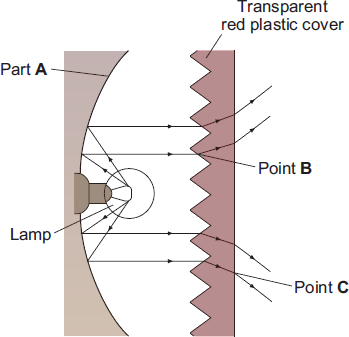GCSE level optics questions
Q13.
At night, it is important that the lights of a car can be seen by other drivers but it is dangerous if these lights dazzle them. The diagram shows a rear light of a car.

(a)
(i) Name part A.
(concave) mirror OR (concave) reflector 
(1 mark)
(ii) Name the process which occurs at point B and at point C.
Refraction 
(1 mark)
(b) A headlamp of a car contains a lens.
The ray diagram shows the position and size of the image, I, of an object, O, formed by a lens similar to the one inside a car headlamp.

Put a tick in the table below to indicate what type of lens is shown in the ray diagram
| converging |
|
| diverging |
|
| plane |
|
(1 mark)
The ray diagram is drawn to scale. Calculate the magnification produced by the lens.
(Show all of your working).
Magnification = Size of image/Size of object 
= 2/0.5 
= 4 
(3 marks)
(Total 6 marks)


